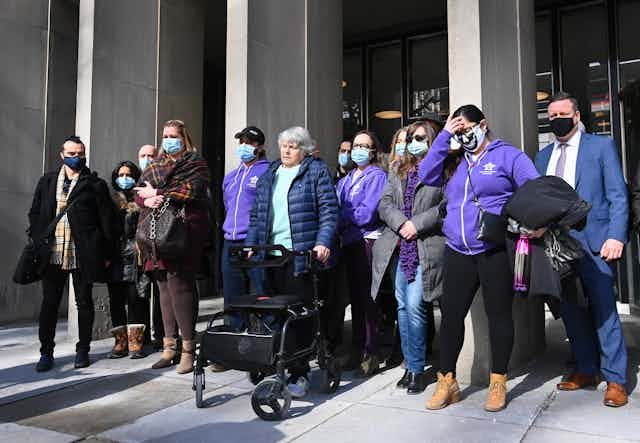Almost three years after the April 23, 2018 van attack in Toronto, a verdict has been reached in the trial against the attacker, Alek Minassian. On March 3, 2021, Justice Anne Molloy from the Ontario Superior Court of Justice delivered a verdict finding Minassian guilty on all 26 counts, specifically 10 counts of first-degree murder and 16 counts of attempted murder.
In the case of Her Majesty the Queen vs. Alek Minassian, the verdict by Justice Malloy was a live-streamed oral statement delivered with a 69-page document divided into 257 sections that outlined the reasoning behind the guilty verdict.
The verdict effectively rejected the argument that Minassian was not criminally responsible for his actions due to autism spectrum disorder. However, advocates for people with autism have said they’re concerned the trial may contribute to the stigmatization of people with disabilities.
Read more: Toronto attack: Autism does not increase risk of violence
For the past three years, we have studied the vulnerability, tactics and motives of this attack. This article analyzes important findings from the 69-page reasons for judgment document to provide a better understanding of the vehicular attack.

Strategic silence
In the final sentence of section 257 of the judgment document, Justice Malloy stated “Accordingly, I find Mr. Doe guilty on all 26 counts on the indictment.”
Justice Malloy made a conscious decision to not use the attacker’s name. “Mr. Doe,” which she used instead, is a name employed by law officials when the identity of a person is unknown or needs to be concealed. That action was the latest twist in a complex debate in both journalism and academic circles concerning strategic silence — when it is appropriate to downplay the names, images and ideologies of perpetrators of mass crime. We have chosen to use Minassian’s name for clarity.
The tactics used in the van attack make the survivors’ recovery difficult. Study of victimization suggests certain types of crimes are qualitatively different from being the victim of an accident, because it includes someone deliberately or recklessly causing harm to others.
In the years after the van attack, physical and emotional scars still run deep in Toronto. The verdict may help some victims cope by providing them with an outcome where a measure of justice has been served. But for others, the entirety of the legal proceedings did little to ease the continued trauma.

Unclear motivations
The judgment document did little to resolve questions about the motivations for the van attack.
Section 192 of the judgment document conceded, “It is almost impossible to tell when Mr. Doe is lying and when he is telling the truth. Working out his exact motivation for this attack is likewise close to impossible.”
Yet in section 193 Justice Malloy stated: “Nevertheless, I am inclined to accept the assessment of all of the experts that Mr. Doe did lie to the police about much of the incel motivation he talked about and that the incel movement was not in fact a primary driving force behind the attack.”
Read more: If misogyny was a factor, is Toronto rampage a terrorist act against women?
Up to this point, many commentators, including the authors, have ascribed motivations for the van attack to Minassian’s adoption of thoughts and actions associated with the incel movement, a self-organized, informal and mainly online movement of “involuntarily celibate” men.
Section 189 of the judgment document stated that Minassian self-assigned 40 per cent of his motivations for the van attack to Elliot Rodger. Rodger wrote a 150-page manifesto linking himself to the incel movement before he killed six people in a 2014 California killing spree.
It is interesting to note that in the Santa Barbara County Sheriff’s Office Investigative Summary of the Isla Vista mass killing, strategic silence was also applied where the misogynistic killer was referred to as “subject,” rather than by his name.
Acknowledgement of heroism
One silver lining to the dark cloud was the remarkable work accomplished by first responders who saved many lives. Ironically, one of those lives saved was that of the attacker. While the arresting officer, Constable Ken Lam, claimed he was not a hero, section five of the judgment document acknowledged his heroism.
Read more: Why didn't he shoot? The Toronto cop who did everything right
Even though Minassian had killed 10 people moments earlier, and provoked the police to shoot him, Lam apprehended the attacker without incident and prevented what may have become suicide by cop.
Due to the acts of restraint and bravery by the responding officer, Minassian survived the police encounter, making it possible for him to stand trial.
Final uncertainties
Despite the finality of the verdict, some issues remain unresolved: Questions of how Canada is going to develop new frameworks to tackle ideological violence. While Minassian was held criminally responsible for his action, the trial did not involve terrorism charges, despite the terrorist-like use of a vehicle as a weapon.
The verdict brings mixed feelings of relief, remembrance and uncertainty to Toronto residents. What is clear, however, is that Toronto is no longer immune to terrorist-like mass casualty attacks, including those initiated by misogynistic, individually motivated violent extremists.

